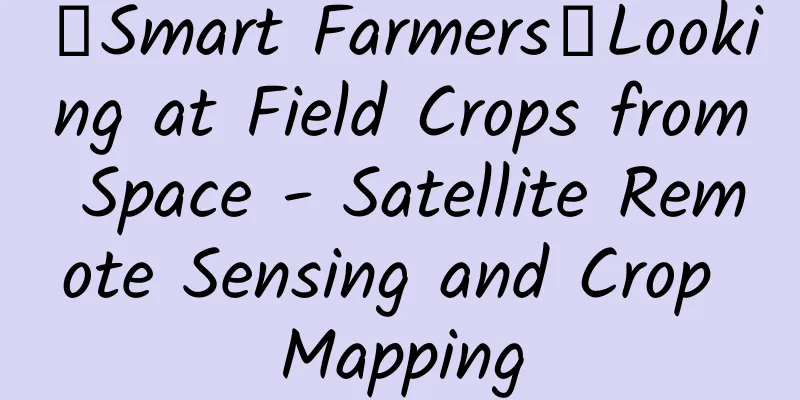【Smart Farmers】Looking at Field Crops from Space - Satellite Remote Sensing and Crop Mapping

|
In the news broadcast, we often hear such reports: On a certain day of a certain month of a certain year, my country successfully launched a certain satellite... So what is a satellite? What are satellites used for? A satellite is a celestial body that orbits a planet in a closed orbit. The moon is the natural satellite of the earth. Unmanned spacecraft built and launched into space by humans that orbit the earth like a natural satellite are also called satellites. So far, humans have launched more than 4,000 satellites into space. In addition to satellites used in scientific experiments and other fields, satellites used to perform business operations can be divided into communication satellites, navigation satellites, and remote sensing satellites. Communication satellites are mainly used as radio communication relay stations to receive and forward radio signals; navigation satellites are mainly used for positioning and navigation, such as my country's Beidou; remote sensing satellites are mainly used to observe the earth system or objects, and can be further divided into meteorological satellites, land satellites and ocean satellites based on the different observation objects. Here, we analyze how to use land satellites to identify crop categories from space. 1. Digital photos and satellite images Taking photos is one of the main functions of mobile phones nowadays. However, you may find it hard to imagine that it is also the main way for land satellites to obtain data. How to take photos of the earth more clearly and quickly has always been one of the main research directions of land satellites. Mobile phones carry cameras, and satellites are also equipped with sensors. Satellites moving in fixed orbits continuously scan the ground through sensors and can periodically obtain photos of the earth, that is, satellite images. Satellite images generally cover a wide range, and the width of a satellite image can reach tens or even thousands of kilometers. The essence of light is electromagnetic waves. Photos obtained by mobile phones or digital cameras generally only contain energy in the three electromagnetic spectrum intervals of red, green and blue, while satellite sensors can further obtain the reflected energy of objects (ground objects) on the earth's surface in the near-infrared, short-wave infrared, microwave and other spectral intervals. Therefore, satellite images contain more available information. Schematic diagram of satellite sensor imaging of the earth (picture from the Internet) 2. Principle of crop identification Where are the fields? What is planted in the fields? How much is planted? This is a major issue related to food security and has attracted much attention from the society. How to use satellites to answer this question? The key lies in how to accurately identify various types of landforms and crops from satellite images. In essence, there is no obvious difference between mobile phone photos and satellite images. In photos, we generally distinguish different objects based on features such as color, shape, and roughness. In the photo shown in Figure 2, we can distinguish landforms such as rice fields, roads, and water bodies based on differences in color and roughness. In fact, the identification of various types of landforms or crops on satellite images is also mainly based on differences in features such as "color". In order to distinguish different landforms based on features such as "color", we must first understand why different landforms have differences in features such as "color", and secondly, what features different landforms have. In photos, the leaves of healthy vegetation such as forests, grasslands, and crops are generally green. This is mainly because the chlorophyll in the leaf cells has the characteristics of absorbing red light and blue-violet light and reflecting green light. Therefore, green occupies a dominant position in the photos in the red, green, and blue channels, making the leaves of vegetation appear green. Rice Field Photos In remote sensing images, due to the different interactions between different objects and electromagnetic waves, the reflected energy of the objects that the satellite can receive is not consistent. This leads to differences in the "color" of different objects in different spectral intervals in remote sensing images, that is, differences in reflectivity (Figure 3). This difference directly reflects the spectral characteristics of different objects. We can distinguish various types of objects from remote sensing images based on differences in reflectivity or other feature differences derived from reflectivity. Of course, in addition to differences in reflectivity, different objects also have different features such as roughness (texture). Generally speaking, comprehensive multi-dimensional features can better identify different objects. Remote sensing image based on red, green and blue band synthesis (left) and reflectivity of main objects (right) 3. Crop identification methods and crop planting area estimation In a large area, different objects may have the same or similar features. In theory, different objects have different reflectances, but in different regions, the reflectance differences of some objects are not obvious, especially for crops. Due to factors such as varieties, climate, and farming measures, the reflectance differences of different crops may be extremely weak. Therefore, high-precision crop identification is not a simple task. At present, the commonly used crop identification methods mainly include machine learning and phenological threshold methods. The machine learning method mainly obtains a certain amount of labeled samples containing real crop information in advance, and then uses the labeled samples to train the machine learning model so that the model "understands" what kind of features correspond to what kind of crops. The model is applied to remote sensing images to determine the category of each pixel on the remote sensing image, and finally achieves the purpose of crop identification. The basic idea of the phenological threshold method is that the characteristics of different crops change with the advancement of the growth process. These changes have certain regularities, and the change laws of different crops show certain differences. By distinguishing the change laws of different crops, the purpose of crop identification can be achieved. Crop identification (left) and planting area estimation (right) based on satellite remote sensing images Whether it is machine learning or phenological threshold method, the spatial distribution of different crops can be obtained based on satellite images (Figure 4). According to the spatial distribution map, we can calculate the number of pixels corresponding to different crops in the spatial distribution map, and then calculate the area of the corresponding crops, so as to achieve accurate measurement of crop planting area. Since satellite images cover a wide range, in theory, crop planting area can be calculated at a national or even global scale. Compared with the traditional method of statistically calculating crop planting area through household surveys and reporting at each level, crop planting area calculation based on satellite remote sensing technology not only saves time and effort, but also clarifies the spatial distribution of various crops, with greater objectivity and credibility. Satellite remote sensing technology has great potential in the field of agricultural monitoring. Contributor: Yang Gaoxiang (PhD student of Smart Agriculture Department, Nanjing Agricultural University) Reviewer: Cheng Tao (Professor and doctoral supervisor of the Department of Smart Agriculture, Nanjing Agricultural University) |
<<: Popular Science Comic丨Why did it suddenly get cold? How much do you know about cold waves?
>>: It's not an allergy! Many people have been infected after "testing positive", doctors remind -
Recommend
"Health from Food" Series | Avoid bad habits to protect your liver
The liver is a very important organ in the human ...
Modern front-end development technology stack
This article will introduce the revolutionary dev...
Straight man’s insights: Why is my wife not afraid of boiling water?
Source: Youlai Healthy Life...
How to buy real fans on Douyin? Where can I buy real fans on Douyin?
As technology becomes more and more powerful, mob...
One picture to understand | Beijing carries out antigen testing! How to read the "two bars" of the new coronavirus?
Beijing will carry out antigen testing among peop...
Beijing’s Central Axis was successfully nominated for World Heritage status. What is the secret behind this axis full of ancient Beijing charm?
Introduction: On July 27, 2024 local time, the 46...
Are the cotton swabs used for nucleic acid testing poisonous? Rumor!
March 28 Shanghai begins a new round of nucleic a...
Swift 3 API Design Guidelines
[[158193]] The design concept of a programming la...
How well do you know the human body?
References: [1] Complete Periodic Table (Part 1):...
It turns out that these common things in life were originally prepared for astronauts!
On October 12, 2024, Lei Zhanxu, Secretary Genera...
Beware of new tricks! A woman cooperated with the "epidemic investigation" and her bank card was emptied
The current epidemic prevention and control situa...
[Hu Yong SEO] Some SEOs have been working for more than ten years but are still rookies. Why is this so?
Some SEOs have been working for more than ten yea...
Does the beginning of winter mean winter? Does it mean winter for you? This article will help you figure it out.
Today is the Beginning of Winter. Does this mean ...
Information flow effect is not good? 80% of the time, there is a problem with the landing page!
Seeing the world through our eyes is an innate ab...
CrossApp 0.4.2 released, grand introduction of WebView
Today is the winter solstice. Besides eating dump...









